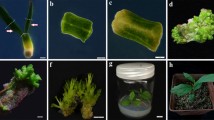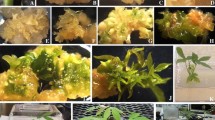Abstract
A novel regeneration system based on direct shoot organogenesis is described for cassava. Plants could be regenerated at high frequency by inducing shoot primordia on explants derived from cotyledons of cassava somatic embryos. After a passage on elongation medium, the regenerated shoots were easily rooted in hormone-free medium and could be successfully transplanted to soil. Using the shoot-organogenesis-based regeneration method, up to eight transplantable plantlets per explant could be regenerated. The system was optimised first for one cassava cultivar, and then its transferability to three other cultivars was demonstrated. This method widens the scope of in vitro regeneration modes of cassava, and is also compatible with Agrobacterium-mediated transformation. To develop an efficient system for production of somatic embryos for regeneration experiments, conditions for inducing primary and cycling somatic embryos were also studied, and highly efficient plant regeneration via germination of somatic embryos was achieved using maltose instead of sucrose in the culture medium, and combining paclobutrazol with 2,4-dichlorophenoxyacetic acid in the embryo induction medium.
Similar content being viewed by others
Author information
Authors and Affiliations
Additional information
Received: 25 January 1997 / Revision received: 10 February 1997 / Accepted: 20 February 1997
Rights and permissions
About this article
Cite this article
Li, HQ., Guo, JY., Huang, YW. et al. Regeneration of cassava plants via shoot organogenesis. Plant Cell Reports 17, 410–414 (1998). https://doi.org/10.1007/s002990050416
Issue Date:
DOI: https://doi.org/10.1007/s002990050416




